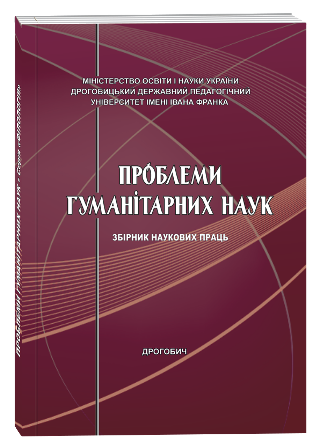ENGLISH TELECOPIC NEONOMINATIONS OF A PERSON
DOI:
https://doi.org/10.24919/2522-4565.2022.49.8Keywords:
telescopy, blending, neonomination, haplology, motivator.Abstract
New blendings are formed in English because the tempo of life is increasing and it becomes necessary to give more and more information in the shortest time. The article deals with telescopy as one of new and productive ways of derivation in Contemporary English. Telescopy has complex nature, its essence means in using the mechanisms of gathering basics (like word formation) and mechanisms of reduction and fragmentation of words (like formatting), in addition, there is a connection between the mechanisms of formation of telescopic units and word formation. There is terminological variability in the research of linguists. In English, the phenomenon of telescopy is called blending, telescoping, telescopic word formation. Words which are formed by telescopy are called blends, fusions, telescopic words, telescopes, portmanteau words. The anthropocentrism is one of the main features at the current stage of development of the scientific paradigm, and a human and everything connected with him / her is occupied the central place in linguistics, so, nouns with the meaning ’a person’ are the subject of the research. The aim of the study is to research the telescopic names of a person in Contemporary English. The aim of the study is to research the telescopic names of a person in Contemporary English. The task of the research is: to determine the corpus of telescopic innovations ’nomina agentis’ and to present synchronous description of semantic-structural connections of the nouns with the motivators. The scientific novelty of the study is to describe these innovations from a lexical and semantic points of view, which include establishing the structure and relationship of derivatives with their motivators. The semantic meaning of the derivative consists mainly of the total value of both motivators belonging to main parts of speech. We have singled out the following models of creating neonominations: neologism ← noun+noun, neologism ← adjective+noun, neologism ← verb+noun, where the second component is mainly a noun with the meaning ’a person’. The study of nominations and the analysis of motivational bases and models of lexical units of different levels are important components of modern linguistic studies.
References
Главацкая Е. И. Субстантивы лица в современных русском и английском языках (структурно-семантический аспект) : монографія. Saarbrücken, Deutschland : LAP LAMBERT Academic Publishing, 2015. 248 с.
Єнікєєва С. М., Єнікєєв Д. С. Роль телескопії в збагаченні лексикону сучасної англійської мови. Науковий вісник Волинського національного університету ім. Лесі Українки. Луцьк, 2010. С. 420–426.
Омельченко Л. Ф, Жихарєва О. О. Прагматичні характеристики англійських телескопізмів. Вісник Житомирського державного університету ім. Івана Франка. Філологічні науки. Житомир, 2010. Вип. 51. С. 12–16.
Шиманович Г. М. Когнітивні чинники еволюції назв осіб в англійській мові ХХ століття : дис. … канд. філол. наук : 10.02.04. Київ : Київський національний університет імені Тараса Шевченка, 2005. 211 с.



